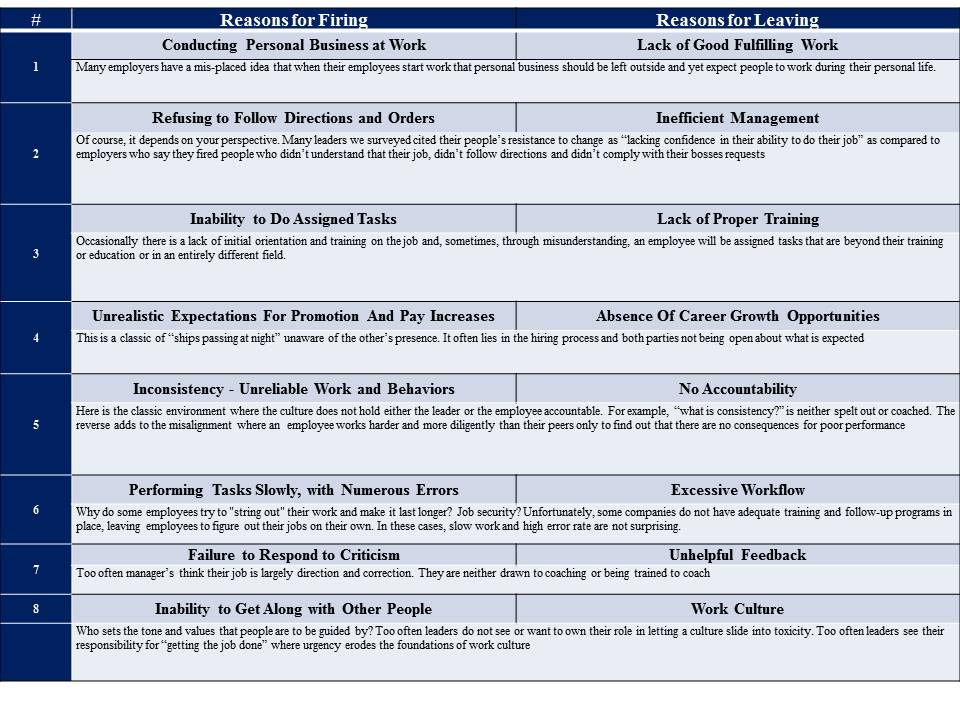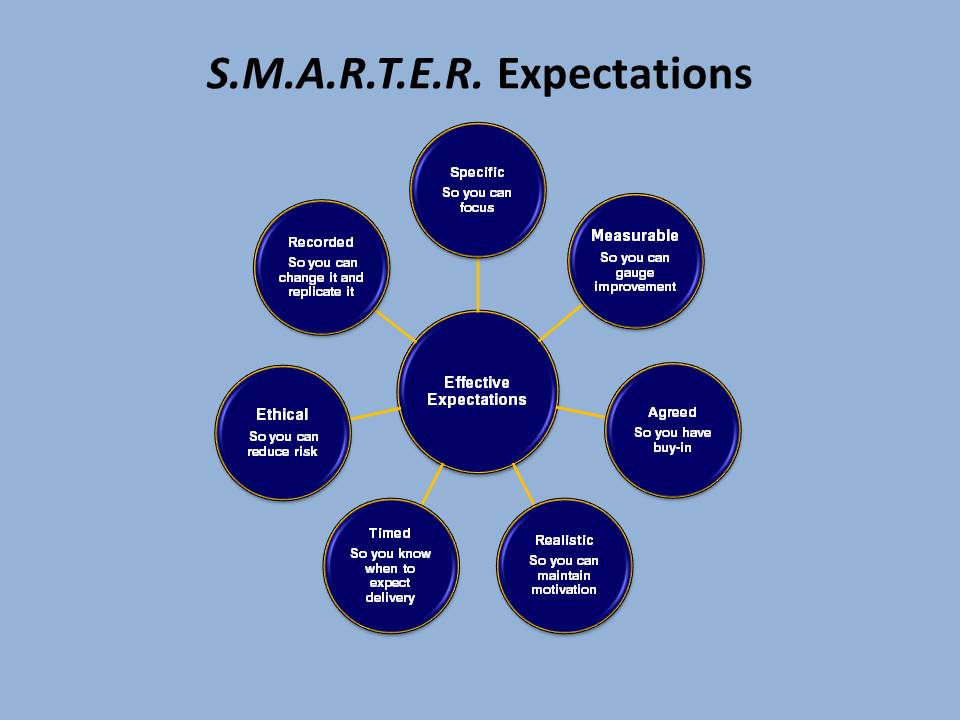(Click on the Play Button to listen to the radio interview with Nick Anderson and see the slides to support his advice)
Nick: Does the phrase “They are not on the same page” sound familiar?
You know that conversation where somebody comes into a room and you are working away and they say:
“What are you doing?” and you reply “I am doing what you told me to do”. The response is “No, that’s not what I meant”.
While there are many variations on this theme, the result is that you walk down the corridor muttering “You have to be a mind reader to work here” Meanwhile the other person is walking away shaking their head saying: “They just don’t get it”
Interviewer: So, now we have discord and misalignment, right?
Nick: Yes, and the unfortunate thing is that the person who said “They don’t get it” is usually the boss and they usually end up firing that person. In the table below, some of the top reasons for firing people are compared with the top reasons for why people leave their company. Ask yourself: How many times could they be the two sides of the same coin?

Interviewer: So, leaders are not as clear as they should be..?
Nick: Unfortunately, our projects show that around 70% of leaders’ expectations, in relation to a change, are either not known or understood by those implementing a change. Thus, the “Mind-Reader” quote.
Interviewer: What are some of those areas that you typically look for misalignment in companies?
Nick: Normally, a client comes to us with:
- “We’ve got to change and we are concerned as we haven’t done this before” or
- “We’ve done this before and it hasn’t worked well but we know we have to change again…”
Like implementing a new computer system, everyone knows that there are going to be problems.
We ask, “What are the people problems you are concerned about?” And we then encourage them to use their own labels, terms and descriptors for those areas. It’s got to be in their language as:
- They will be talking to their people about it
- They are going to be communicating it
- They are going to be coaching it and above all leading to it
Interviewer: Yes, it ends up being about me and it’s not about you as a consultant, it’s about you and what your company needs to change. I have heard it said that 1% of a company is vision and 99% is getting alignment to that vision. What sort of expectations should you be looking for or setting?
Nick: First, align and coach people on what an expectation is and is not. Very often they will say:
“We’ve got to cut costs” or “We have to increase sales”…”We’ve got to improve our quality”
These are goals not expectations to each person to achieve that goal. A quality expectations has to meet the following SMARTER criteria

Obviously, leaders kick-off a change with their expectations and not even ask for their people’s expectations of them. And even when they do try to get expectations from their people, they are told what they think the boss wants to here.
Yet what is needed are genuine expectations. Here, we use a little used word “elicit” – To elicit expectations. This word is different as it is about creating the environment so that people give me what they expect not what they think they want me to say.
Some of the most valuable people in a change are your skeptics like your most experienced technician, longest serving sales person or quality control manager. These people will be skeptical which means they are going to question you. And you need that to get the change to work. Your skeptics can be your best ally if your show that you have listened and shown respect for their experience, not necessarily agree with them. If you can bring those people around others will take a lot of notice>
“Well, Jill is actually in favor of this” “You know Frank says he thinks it could work…”
Then suddenly a group of people start saying:
“Ok.”
Interviewer: How do you get people to comply with those expectations?
Nick: Compliance is a funny word. It really implies not having the right environment, like people telling you what they think you want to hear. We’ve sat down and talked about expectations. The critical thing is this. Does what I expect of you match with what you thought I expected. That testing understanding is so important
Interviewer: Do you think that we’re so busy that people aren’t taking time to be thorough in their communications
Nick: It comes down to Festina Lente or Make Haste Slowly (Suetonius 70 AD). The best leaders of change are, it’s a clumsy phrase but accurate, RADICAL GRADUALISTS
Like Fred Smith, his vision was and still is “Anywhere, Overnight, Guaranteed”
It required a change of legislation to get FedEx up and running. But, he knew that it would only be achieved by small changes every day.
It’s gradual not the big gala and RARA events that create successful change. That’s event-based rather than process-based change. It’s that clear radical vison with the recognition and support for daily and gradual change.
Interviewer: How do I get expectations from others and get buy-in to execution?
Nick: If I have 13 expectations of you and you think I have 12 – sounds close right? But on the other hand what I don’t realize is that you have 22 expectations of me when I only thought you had 4. And, that’s real data from two executives on a major project. And, that pattern was repeated across the leadership team. Everyone knew what the project leader expected but Dave had little idea of their expectations of him.
The other thing about an expectation is there is a process to realize genuine alignment. It works like this:
- Do you agree with my expectation? Yes. Have you got alignment? No. You’ve made an important start – Agreement
- Now you ask the person who has agreed to your expectation”
- What are you going to be delivering or showing me to meet my expectation
- Then, you are going to hear a lot of things that indicates that they fully understand you expectation or you have not made yourself clear and in many cases refine or create greater specificity of that expectation.
- On agreeing how this expectation is to be met, the expectation holder has to ask” What help does this person need to meet my expectation?”. For example, budget, political support, coaching and training.
The point is that you can’t absolve yourself just because you told the person what you expected. I have to really make sure as I don’t want to have the conversation:
- What are you doing?
- In am doing want you asked me to do
- No, that’s not what I meant
We don’t need that. The competition is out there and we need everyone to meet that challenge not to bicker internally. It relates to why people resist change in both your own organization and those you recruit. They all have baggage and it’s really talking to them when planning a change like:
- Talk to me your experience of change and really hearing them as well as establishing a too often unusual dialogue
- Oops, I am going to be listened to…Oops my views are going to be taken into account
This really opens and gives currency to talking about change readiness and respecting that individuals are individually resistant to change. So, individualize your change.
Change Is Personal Before It Can Ever Be Organizational
If you look in our book, Focusing Change To Win, based on a survey of 1000+ managers from 80 countries and 19 industry sectors, the most mentioned way of communicating change is email. One way communication is endemic is in organizational life. Yet, successful change is about one-on-one time with your senior sales person or your new programmer or customer service center manager talking about change and their attitudes toward it.
Interviewer: I don’t think there is any substitute for face-to-face engagement that helps us see, hear and feel what we are talking about it
Nick: And face-to-face doesn’t mean a computer screen. It means being in the same place. Being present with people. And today, it is so much more valued as they areswamped by staring at a social media screens…..
[contact-form][contact-field label=’Name’ type=’name’ required=’1’/][contact-field label=’Email’ type=’email’ required=’1’/][contact-field label=’Website’ type=’url’/][contact-field label=’Comment’ type=’textarea’ required=’1’/][/contact-form]
